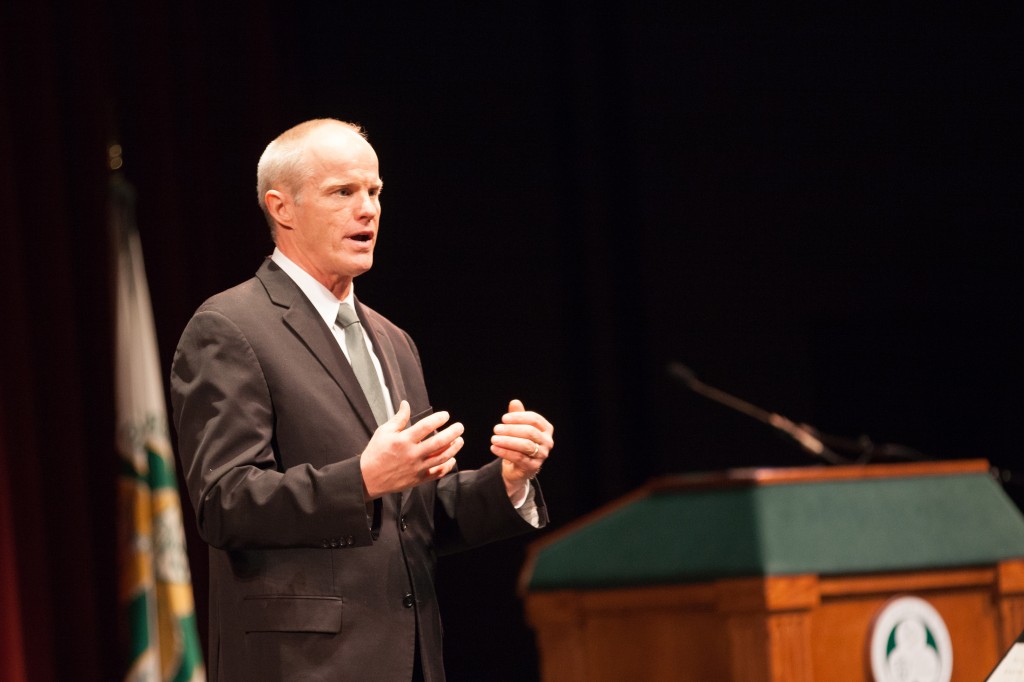
Operating under the philosophy that bigger can be better without compromising quality, Binghamton University President Harvey Stenger addressed the growth of Binghamton University, looking as far into the future as 2020 at his State of the University address on Friday.
Stenger structured his State of the University address to coincide with the strategic priorities in his “Road Map to Premier” plan.
The Road Map, BU’s strategic five-priority plan, involves growth in graduate education, transforming BU’s learning environment, increasing diversity, enhancing economic, social and cultural impact and optimizing and acquiring resources.
As part of the “20 by 2020” goal of enrolling 20,000 students (14,000 undergraduate and 6,000 graduate students), Stenger listed several strategies in the University plan.
“If you can get bigger and you can get better, do it,” Stenger said, defining the goal as an “aggressive target.”
As part of the Road Map’s first priority regarding graduate education — research, scholarship and creative activities — Stenger spoke on the Graduate Growth Initiative (GGI) and its six areas of focus.
“As we look to the future, we know as we compare ourselves to other schools that we are small as a graduate institution and we need new ideas, and new programs, and to expand our existing programs to become the premier public university,” Stenger said.
As these programs grow, more faculty will be required to support the additional students. According to Stenger, faculty can be hired at a faster rate than students are being admitted, lowering the student-to-faculty ratio.
Plans for the School of Pharmaceutical Sciences and Pharmacy are still underway, with $10 million being set aside by Gov. Andrew Cuomo for its construction.
“We need a school that takes advantage of the great research that’s occurring on this campus in the area of pharmaceutical sciences,” Stenger said.
With graduate applications up 23 percent and fall enrollment 10 percent higher between last year and this year, Stenger stressed the importance of investing in research.
According to Stenger, $7.5 million per year is now invested to get researchers here, get them in laboratories and make sure they are successful.
Stenger addressed plans for expansion beyond campus, including ideas for a greater Downtown presence. However, administrators are unsure as to exactly where that would be.
“I think we’ve proven to ourselves in the last three years that we can get bigger and get better at the same time,” Stenger said. “But then we have to make a decision: Where do we grow?”
As part of the Road Map priority regarding regional, national and international impact, Stenger spoke on the ways in which BU has stimulated the economy.
“We’re Downtown, and we’re growing our student population,” Stenger said. “If you take that as a business model, that’s like bringing a $30 million a year company into the region.”
Additionally, Stenger proposed Binghamton’s 4-1-1 program, which is aimed at providing paid experiential opportunities to recent graduates and assistance for alumni.
“Almost half of [our seniors], when they graduate, are still looking for jobs,” Stenger said. “The first thing they need is experience.”
This program offers recent graduates opportunities for nine months of career-based, credit-bearing internships and coursework.
Unlike previous years, this year’s address took place in the middle of the academic year, as opposed to over winter break, so both faculty and students on campus were able to attend, though most of the audience was faculty and staff.
Speaking on behalf of the student body, Student Association President Eric Larson was the first student to speak at the State of the University address.
“Binghamton entrusts its student with more responsibility, and it’s precisely because of that that we have more opportunity,” Larson said. “What drew me and a good portion of the students to Binghamton was the price … but what kept me here were those very opportunities.”
According to Stenger, the increase to 20,000 students will be met by hiring 180 teaching assistants, 180 faculty and 100 staff members.
Stenger addressed that growth in its various forms is necessary for a public university that has demands to meet.
“I don’t want to chase the premier publics out there,” Stenger said. “I want to define the premier as we get there.”


